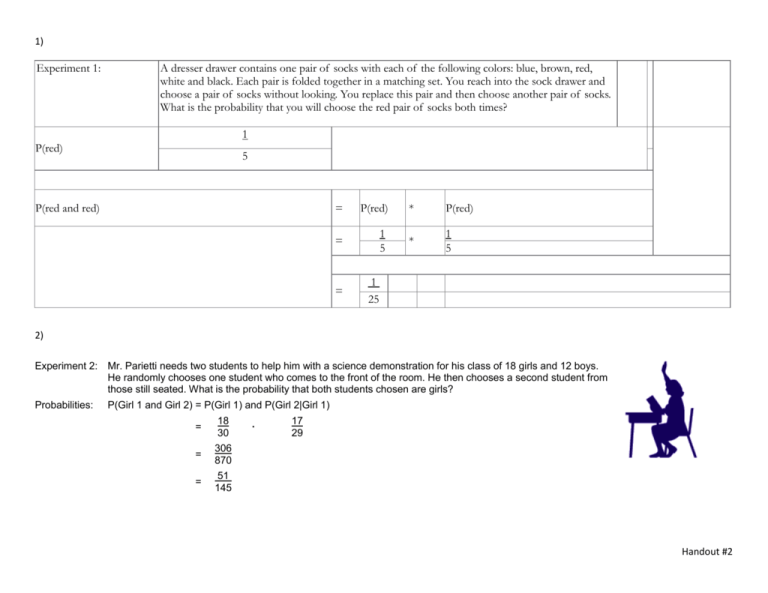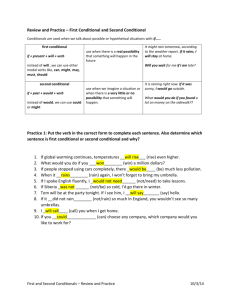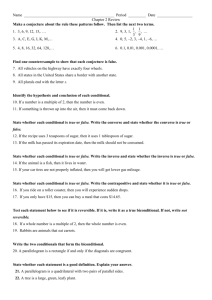Summary: The conditional probability of an event B in relationship to
advertisement

1) Experiment 1: A dresser drawer contains one pair of socks with each of the following colors: blue, brown, red, white and black. Each pair is folded together in a matching set. You reach into the sock drawer and choose a pair of socks without looking. You replace this pair and then choose another pair of socks. What is the probability that you will choose the red pair of socks both times? 1 P(red) 5 P(red and red) = P(red) * P(red) = 1 5 * 1 5 = 1 25 2) Experiment 2: Mr. Parietti needs two students to help him with a science demonstration for his class of 18 girls and 12 boys. He randomly chooses one student who comes to the front of the room. He then chooses a second student from those still seated. What is the probability that both students chosen are girls? Probabilities: P(Girl 1 and Girl 2) = P(Girl 1) and P(Girl 2|Girl 1) = 18 30 = 306 870 = 51 145 · 17 29 Handout #2 Problem: A math teacher gave her class two tests. 25% of the class passed both tests and 42% of the class passed the first test. What percent of those who passed the first test also passed the second test? Analysis: This problem describes a conditional probability since it asks us to find the probability that the second test was passed given that the first test was passed. In the last lesson, the notation for conditional probability was used in the statement of Multiplication Rule 2. The formula for the Conditional Probability of an event can be derived from Multiplication Rule 2 as follows: Start with Multiplication Rule 2. Divide both sides of equation by P(A). Cancel P(A)s on right-hand side of equation. Commute the equation. We have derived the formula for conditional probability. Now we can use this formula to solve the problem at the top of the page. Problem: A math teacher gave her class two tests. 25% of the class passed both tests and 42% of the class passed the first test. What percent of those who passed the first test also passed the second test? Solution: P(Second|First) = P(First and Second) 0.25 = = 0.60 = 60% P(First) 0.42 Handout #3 Let's look at some other problems in which we are asked to find a conditional probability. Example 1: Solution: Example 2: Solution: A jar contains black and white marbles. Two marbles are chosen without replacement. The probability of selecting a black marble and then a white marble is 0.34, and the probability of selecting a black marble on the first draw is 0.47. What is the probability of selecting a white marble on the second draw, given that the first marble drawn was black? P(White|Black) = P(Black and White) 0.34 = = 0.72 = 72% P(Black) 0.47 The probability that it is Friday and that a student is absent is 0.03. Since there are 5 school days in a week, the probability that it is Friday is 0.2. What is the probability that a student is absent given that today is Friday? P(Absent|Friday) = P(Friday and Absent) 0.03 = = 0.15 = 15% P(Friday) 0.2 Example 3: At Kennedy Middle School, the probability that a student takes Technology and Spanish is 0.087. The probability that a student takes Technology is 0.68. What is the probability that a student takes Spanish given that the student is taking Technology? Solution: P(Spanish|Technology) = Summary: P(Technology and Spanish) 0.087 = = 0.13 = 13% P(Technology) 0.68 The conditional probability of an event B in relationship to an event A is the probability that event B occurs given that event A has already occurred. The notation for conditional probability is P(B|A), read as the probability of B given A. The formula for conditional probability is: Handout #3






